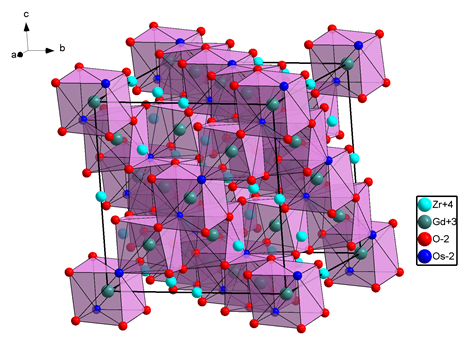
Synthesis, structure and electrical properties of Li+-doped pyrochlore Gd2Zr2O7
Abstract
Keywords
Full Text:
PDFReferences
Merwin A, Williamson MA, Willit JL, Chidambaram D. Review-Metallic lithium and the reduction of actinide oxides. Journal of the Electrochemical Society. 2017;164(8):H5236–46. doi:10.1149/2.0251708jes
Choi EY, Lee J. Complete reduction of high-density UO2 to metallic U in molten Li2O-LiCl. Journal of Nuclear Materials. 2017;494:439–47. doi:10.1016/j.jnucmat.2017.07.036
Willit JL, Miller WE, Battles JE. Electrorefining of uranium and plutonium - A literature review. Journal of Nuclear Materials. 1992;195(3):229–49. doi:10.1016/0022-3115(92)90515-M
Choi EY, Choi IK, Hur JM, Kang DS, Shin HS, Jeong SM. In situ electrochemical measurement of O2- concentration in molten Li2O/LiCl during uranium oxide reduction process. Electrochemical and Solid-State Letters. 2012;15(3):E11–E13. doi:10.1149/2.016203esl
Cho SH, Kim DY, Kwon S, Yoon BH, Lee JH. High-temperature corrosion characteristics of yttria-stabilized zirconia material in molten salts of LiCl-Li2O and LiCl-Li2O-Li. Journal of Nuclear Science and Technology. 2018;55(1):97–103. doi:10.1080/00223131.2017.1383214
Cho SH, Kim SW, Kim DY, Lee JH, Hur JM. Hot corrosion behavior of magnesia-stabilized ceramic material in a lithium molten salt. Journal of Nuclear Materials. 2017;490:85–93. doi:10.1016/j.jnucmat.2017.04.012
Lehmann H, Pitzer D, Pracht G, Vassen R, Stoever D. Thermal conductivity and thermal expansion coefficients of the lanthanum rare-earth-element zirconate system. Journal of the American Ceramic Society. 2003;86(8):1338–44. doi:10.1111/j.1151-2916.2003.tb03473.x
Radha AV, Ushakov SV, Navrotsky A. Thermochemistry of lanthanum zirconate pyrochlore. Journal of Materials Research. 2009;24(11):3350–7. doi:10.1557/jmr.2009.0401
Volkov VN, Vykhodets VB, Golubkov IK, Klotsman SM, Lerkh PV, Pavlov VA. Accurate light ion beam monitoring by backscattering. Nucl Instrum and Meth. 1983;205:73-7. doi:10.1016/0167-5087(83)90175-8
Ziegler JF. Biersack JP. The stopping and ranges of ions in matter. New York: Pergamon Press; 1977.
Vykhodets VB, Klotsman SM, Levin AD. Oxygen diffusion in α-Ti: II. The calculation of the concentration profile of impurities in the nuclear microanalysis. The Phys. Metal & Metallogr. 1987;64:920–4.
Wuensch BJ, Eberman KW, Heremans C, Ku EM, Onnerud P, Yeo EME, Haile SM, Stalick JK, Jorgensen JD. Connection between oxygen-ion conductivity of pyrochlore fuel-cell materials and structural change with composition and temperature. Solid State Ionics. 2000;129:111–33. doi:10.1016/S0167-2738(99)00320-3
Zhang FX, Lang M, and Ewing RC. Atomic disorder in Gd2Zr2O7 pyrochlore. Applied Physics Letters. 2015;106:191902. doi:10.1063/1.4921268
Shannon RD. Revised effective ionic radii and systematic studies of interatomic distances in halides and chalcogenides. Acta Cryst. 1976;A32:751–67. doi:10.1107/S0567739476001551
Michel D, Perez M, Jorba, Collongues R. Etude de la Transformation Ordre–De´sordre de la Structure Fluorite a` la Structure Pyrochlore pour des Phases (1-x) ZrO2 -x Ln2O3. Mater Res Bull. 1974;9:1457–68.
Uehara T, Koto K, Emura S, Kanamaru F. EXAFS study of fluorite and pyrochlore compounds in the system ZrO – GdO. Solid State Ionics. 1987;23:331–7. doi:10.1016/0167-2738(87)90012-9
Scheetz BE, White WB. Characterization of anion disorder in zirconate A2B2O7 compounds by Raman spectroscopy. J. Am. Ceram. Soc. 1979;62:468–70. doi:10.1111/j.1151-2916.1979.tb19107.x
Khal HEl, Cordier A, Batis N, Siebert E, Georges S, Steil MC. Effect of porosity on the electrical conductivity of LAMOX materials. Solid State Ionics. 2017;304:75–84. doi:10.1016/j.ssi.2017.03.028
Catlow CRA. Defects and disorder in crystalline and amorphous solids. Springer Science+Business Media Oordrecht; 1994. doi:10.1007/978-94-011-1942-9
Van Dijk MP, De Vries KJ, Burggraaf AJ. Electrical conductivity and defect chemistry of the system (TbxGd1−x)2Zr2O7+y (O≦x≦1;O≦y<0.25). Solid State Ionics. 1985;16:211–4. doi:10.1016/0167-2738(85)90045-1
DOI: https://doi.org/10.15826/chimtech.2020.7.2.02
Copyright (c) 2020 Irina A. Anokhina, Irina E. Animitsa, Anastasia F. Buzina, Vladimir I. Voronin, Vladimir B. Vykhodets, Tatyana E. Kurennykh, Yuri P. Zaikov

This work is licensed under a Creative Commons Attribution 4.0 International License.
Chimica Techno Acta, 2014–2025
eISSN 2411-1414
Copyright Notice






